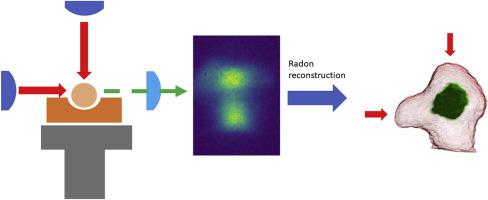当前位置:
X-MOL 学术
›
Anal. Chim. Acta
›
论文详情
Our official English website, www.x-mol.net, welcomes your
feedback! (Note: you will need to create a separate account there.)
Tomography of double-pulse laser-induced plasmas in the orthogonal geometry
Analytica Chimica Acta ( IF 5.7 ) Pub Date : 2020-10-01 , DOI: 10.1016/j.aca.2020.06.078 Erik Képeš , Igor Gornushkin , Pavel Pořízka , Jozef Kaiser
Analytica Chimica Acta ( IF 5.7 ) Pub Date : 2020-10-01 , DOI: 10.1016/j.aca.2020.06.078 Erik Képeš , Igor Gornushkin , Pavel Pořízka , Jozef Kaiser

|
The temporal evolution of laser-induced plasmas is studied in the orthogonal double-pulse arrangement. Both the pre-ablation mode (an air spark is induced above the sample surface prior to the ablation pulse) and the re-heating mode (additional energy is delivered into the plasma created by the ablation pulse) is considered. The plasmas are investigated in terms of the temporal evolution of their electron density, temperature, and volume. The plasma volumes are determined using a time-resolved tomography technique based on the Radon transformation. The reconstruction is carried out for both white-light and band-pass filtered emissivities. The white-light reconstruction corresponds to the overall size of the plasmas. On the other hand, the band-pass emissivity reconstruction shows the distribution of the atomic sample species (Cu I). Moreover, through spectrally resolved tomographic reconstruction, the spatial homogeneity of the electron density and temperature of the plasmas is also investigated at various horizontal slices of the plasmas. Our results show that the pre-ablation geometry yields a more temporally stable and spatially uniform plasma, which could be beneficial for calibration-free laser-induced breakdown spectroscopy (LIBS) approaches. On the contrary, the plasma generated in the re-heating geometry exhibits significant variations in electron density and temperature along its vertical axis. Overall, our results shed further light on the mechanisms involved in the LIBS signal enhancement using double-pulse ablation.
中文翻译:

正交几何中双脉冲激光诱导等离子体的层析成像
在正交双脉冲排列中研究了激光诱导等离子体的时间演化。预烧蚀模式(在烧蚀脉冲之前在样品表面上方引起空气火花)和再加热模式(额外能量被传递到烧蚀脉冲产生的等离子体中)都被考虑。根据它们的电子密度、温度和体积的时间演变来研究等离子体。使用基于氡变换的时间分辨断层扫描技术确定血浆体积。对白光和带通滤波发射率进行重建。白光重建对应于等离子体的整体尺寸。另一方面,带通发射率重建显示了原子样品种类 (Cu I) 的分布。而且,通过光谱分辨断层扫描重建,还在等离子体的不同水平切片上研究了等离子体的电子密度和温度的空间均匀性。我们的结果表明,预烧蚀几何形状产生了更时间稳定和空间均匀的等离子体,这可能有利于免校准激光诱导击穿光谱 (LIBS) 方法。相反,在再加热几何结构中产生的等离子体沿其垂直轴表现出电子密度和温度的显着变化。总的来说,我们的结果进一步阐明了使用双脉冲消融增强 LIBS 信号的机制。还在等离子体的不同水平切片上研究了等离子体的电子密度和温度的空间均匀性。我们的结果表明,预烧蚀几何形状产生了更时间稳定和空间均匀的等离子体,这可能有利于免校准激光诱导击穿光谱 (LIBS) 方法。相反,在再加热几何结构中产生的等离子体沿其垂直轴表现出电子密度和温度的显着变化。总的来说,我们的结果进一步阐明了使用双脉冲消融增强 LIBS 信号的机制。还在等离子体的不同水平切片上研究了等离子体的电子密度和温度的空间均匀性。我们的结果表明,预烧蚀几何形状产生了更时间稳定和空间均匀的等离子体,这可能有利于免校准激光诱导击穿光谱 (LIBS) 方法。相反,在再加热几何结构中产生的等离子体沿其垂直轴表现出电子密度和温度的显着变化。总的来说,我们的结果进一步阐明了使用双脉冲消融增强 LIBS 信号的机制。这可能有利于免校准的激光诱导击穿光谱 (LIBS) 方法。相反,在再加热几何结构中产生的等离子体沿其垂直轴表现出电子密度和温度的显着变化。总的来说,我们的结果进一步阐明了使用双脉冲消融增强 LIBS 信号的机制。这可能有利于免校准的激光诱导击穿光谱 (LIBS) 方法。相反,在再加热几何结构中产生的等离子体沿其垂直轴表现出电子密度和温度的显着变化。总的来说,我们的结果进一步阐明了使用双脉冲消融增强 LIBS 信号的机制。
更新日期:2020-10-01
中文翻译:

正交几何中双脉冲激光诱导等离子体的层析成像
在正交双脉冲排列中研究了激光诱导等离子体的时间演化。预烧蚀模式(在烧蚀脉冲之前在样品表面上方引起空气火花)和再加热模式(额外能量被传递到烧蚀脉冲产生的等离子体中)都被考虑。根据它们的电子密度、温度和体积的时间演变来研究等离子体。使用基于氡变换的时间分辨断层扫描技术确定血浆体积。对白光和带通滤波发射率进行重建。白光重建对应于等离子体的整体尺寸。另一方面,带通发射率重建显示了原子样品种类 (Cu I) 的分布。而且,通过光谱分辨断层扫描重建,还在等离子体的不同水平切片上研究了等离子体的电子密度和温度的空间均匀性。我们的结果表明,预烧蚀几何形状产生了更时间稳定和空间均匀的等离子体,这可能有利于免校准激光诱导击穿光谱 (LIBS) 方法。相反,在再加热几何结构中产生的等离子体沿其垂直轴表现出电子密度和温度的显着变化。总的来说,我们的结果进一步阐明了使用双脉冲消融增强 LIBS 信号的机制。还在等离子体的不同水平切片上研究了等离子体的电子密度和温度的空间均匀性。我们的结果表明,预烧蚀几何形状产生了更时间稳定和空间均匀的等离子体,这可能有利于免校准激光诱导击穿光谱 (LIBS) 方法。相反,在再加热几何结构中产生的等离子体沿其垂直轴表现出电子密度和温度的显着变化。总的来说,我们的结果进一步阐明了使用双脉冲消融增强 LIBS 信号的机制。还在等离子体的不同水平切片上研究了等离子体的电子密度和温度的空间均匀性。我们的结果表明,预烧蚀几何形状产生了更时间稳定和空间均匀的等离子体,这可能有利于免校准激光诱导击穿光谱 (LIBS) 方法。相反,在再加热几何结构中产生的等离子体沿其垂直轴表现出电子密度和温度的显着变化。总的来说,我们的结果进一步阐明了使用双脉冲消融增强 LIBS 信号的机制。这可能有利于免校准的激光诱导击穿光谱 (LIBS) 方法。相反,在再加热几何结构中产生的等离子体沿其垂直轴表现出电子密度和温度的显着变化。总的来说,我们的结果进一步阐明了使用双脉冲消融增强 LIBS 信号的机制。这可能有利于免校准的激光诱导击穿光谱 (LIBS) 方法。相反,在再加热几何结构中产生的等离子体沿其垂直轴表现出电子密度和温度的显着变化。总的来说,我们的结果进一步阐明了使用双脉冲消融增强 LIBS 信号的机制。











































 京公网安备 11010802027423号
京公网安备 11010802027423号